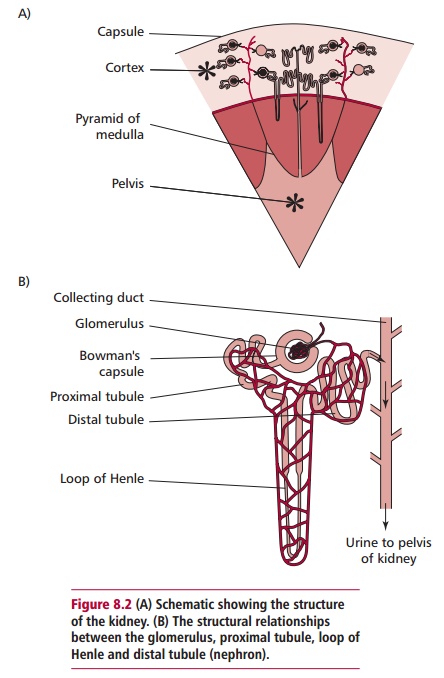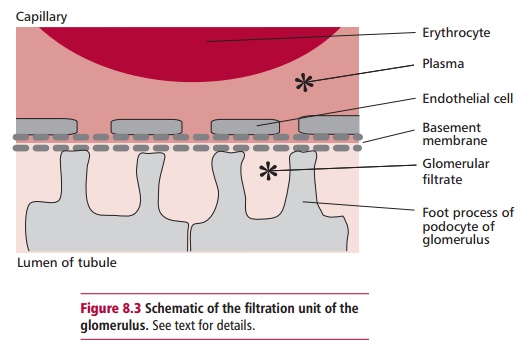Chapter: Biology of Disease: Disorders of Water, Electrolytes and Urate Balances
Renal Failure: Acute and Chronic renal failure
RENAL FAILURE
Renal failure is the cessation of renal function and it can be acute or chronic. In acute renal failure there is rapid loss of renal function within hours or days, although the condition is potentially reversible and normal renal function can be regained. The deterioration is sudden, with increases in the concentrations of urea, creatinine and H+ in serum. Patients with acute renal failure often, but not always, present with oliguria, where there is less than 400 cm3 of urine
passed per day. Indeed, patients are sometimes anuric and do not pass any urine at all. Chronic renal failure is the gradual, progressive deterioration of kidney function. As kidney function declines, there is accumulation of waste products that eventually reach toxic levels in the blood and may affect other organs.
Acute renal failure
Acute renal failure can be categorized as prerenal, where the loss in renal function is due to a decrease in renal blood flow, postrenal, where the loss is due to an obstruction of the urinary tract, or intrinsic, where the loss is due to damage to the kidney itself.
Prerenal kidney failure can occur because of a decreased plasma volume following blood loss, burns, prolonged diarrhea or vomiting, decreased cardiac output or occlusion of the renal artery. Whatever the reason, prerenal acute renal failure results in a low GFR and decreased blood flow to kidneys. Aldosterone and antidiuretic hormone release is stimulated by the low blood pressure and the kidneys respond by producing smaller volumes of concentrated urine. The biochemical indicators of prerenal acute renal failure include increased amounts of urea and creatinine in serum due to the low GFR, metabolic acidosis , because of an inability of the kidneys to excrete H+, and hyperkalemia because of the low GFR and acidosis. Postrenal kidney damage can be the consequence of a blockage of the urinary tract by, for example, renal calculi, kidney stones or neoplasms. These obstructions increase the hydrostatic pressure that opposes glomerular filtration. If this persists for a sufficiently long time it can causeintrinsic renal damage. If pre- or postrenal acute failures are not corrected,patients can develop intrinsic renal damage. A variety of conditions cause intrinsic acute renal failure. These include nephrotoxins, for example drugs such as aminoglycosides and analgesics, septic shock, a low cardiac output , burns or crush injuries and renal diseases, such as glomerulonephritis. Glomerulonephritis is inflammation of the renal cortex which affects the filtration mechanism of the kidney. It may develop following an infection.
Three phases occur in acute renal failure. The first is an oliguric phase with a low urine output. The second is a diuretic phase where the urine output increases while the third is a recovery phase when normal function returns. The oliguric phase is characterized by increased concentrations of K+, urea, creatinine and H+ in the serum. If the patient survives the oliguric phase, then urine output increases after a few days when the diuretic phase starts. The GFR increases during the diuretic phase and as the output of urine increases the amounts of urea and creatinine in the serum gradually fall. Tubular function may still be abnormal in this phase so that the acidosis may still persist. In the recovery phase, tubular cells regenerate and tubular function is restored to normal. The concentrations of urea and creatinine in serum decrease and K+returns to normal levels as the GFR improves.
The management of acute renal failure includes correction of prerenal factors if they are present. This could be achieved, for example by increasing the extracellular fluid volume by administering fluids. Biochemical monitoring of creatinine and K+ is required and dialysis may be necessary when K+ concentrations are high or when severe acidosis is present. The cause of the renal failure should be identified and treated wherever possible.
Chronic renal failure
Many diseases, such as glomerulonephritis, diabetes mellitus, hypertension and polycystic kidney disease, can lead to irreversible renal damage. All these conditions effectively decrease the number of functioning nephrons. Patients may remain asymptomatic until the GFR falls below 15 cm3 min–1. Chronic renal failure progresses to end-stage renal failure (ESRF) where dialysis or a kidney transplant is necessary for survival. Metabolic features of ESRF include the impairment of urinary concentration and dilution, abnormal electrolyte and H+ homeostasis, the retention of waste products and decreased syntheses of erythropoietin and calcitriol. Chronic renal failure is accompanied by increases in the concentrations of K+, urea, creatinine, Pi and H+ and decreased Ca2+ in the plasma.
Patients with chronic renal failure often present with a number of clinical features including neurological symptoms, such as lethargy, growth failure, myopathy, anorexia, nausea, vomiting, anemia, hypertension, nocturia and impotence. The causes of many of these are not known but are probably due to the retention of toxins that cannot be excreted.
In some cases, it is possible to delay the progression of the disease by treating its cause. A number of measures may be taken to alleviate symptoms before dialysis becomes necessary. These include careful matching of water and Na+ intake with their losses. High blood K+ is controlled with oral ion exchange resins given as their Ca2+ or Na+salts whereas a high blood Pi is controlled by oral aluminum or magnesium salts that precipitate ingested phosphate in the GIT. A restriction of dietary protein may reduce the formation of nitrogenous waste.


Related Topics